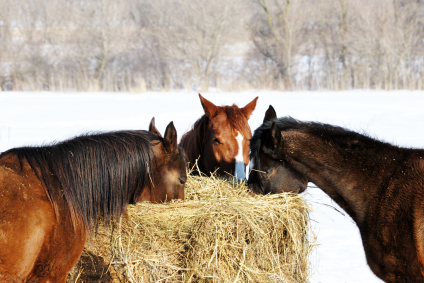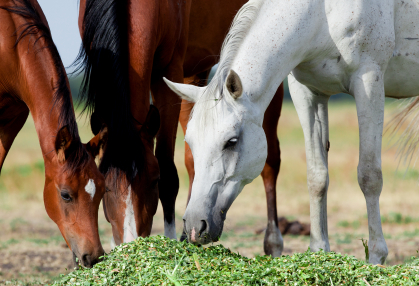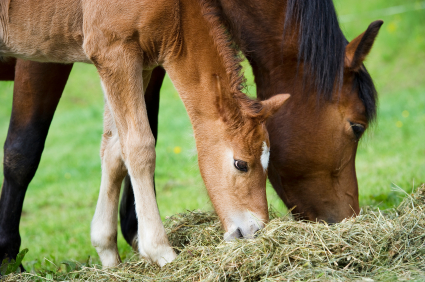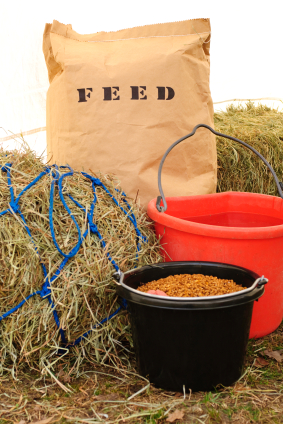 Forage should be the foundation of every horse’s ration. For most horses in the winter months this means hay and in certain locations where pasture is not practical in the summer hay has traditionally been the year long source of forage. However with some parts of the country reporting that only half the normal amount of hay was harvested and put up this year many owners are experiencing hay shortages and or high prices. This can be a particular challenge for breeders as broodmares and growing youngstock require high quality forage. Here are some ways that you can make the most of your hay budget and stretch what hay you do have in the barn this winter.
Forage should be the foundation of every horse’s ration. For most horses in the winter months this means hay and in certain locations where pasture is not practical in the summer hay has traditionally been the year long source of forage. However with some parts of the country reporting that only half the normal amount of hay was harvested and put up this year many owners are experiencing hay shortages and or high prices. This can be a particular challenge for breeders as broodmares and growing youngstock require high quality forage. Here are some ways that you can make the most of your hay budget and stretch what hay you do have in the barn this winter.
Whenever Possible Buy Hay in Bulk
While the initial financial outlay is greater, in the long run you are likely to save money as prices tend to go up as the winter goes on. Hay availability goes down the further we are into winter and therefore prices rise with demand. Check with your local Farm Bureau or state Department of Agriculture to see if they maintain a hay directory for your area. Here is an example of one such directory in Tennessee. Know how much hay you feed to your herd each day and calculate the amount of hay you will need between now and the next time hay will be easily available and buy accordingly. For the best prices, consider trying to find a grower and buying off the field next year.
Another benefit of buying in bulk is that your horses receive a more constant plain of nutrition. While you may buy the same type of hay multiple times during the year and it may look the same the nutrient content will fluctuate between loads. This can lead to changes in growth rate and condition and in some sensitive individuals can cause digestive upset. Buying in bulk means that you can get your hay tested and then build a well balanced ration around the hay insuring that all nutrient needs are met.
Store Properly
 Storage losses are inevitable but steps should be taken to minimize them. The more moisture in the hay at baling the greater the risk of mold and loss, hay should have a moisture content of less than 20% at baling for this reason. Barn stored hay experienced the smallest lost but even barn storage will not reduce the loss experiences when hay is baled with more than 20% moisture. Round bales tend to display the greatest loss which has nothing to do with the baling process and more to do with the fact that many people store round bales in poor conditions outside.
Storage losses are inevitable but steps should be taken to minimize them. The more moisture in the hay at baling the greater the risk of mold and loss, hay should have a moisture content of less than 20% at baling for this reason. Barn stored hay experienced the smallest lost but even barn storage will not reduce the loss experiences when hay is baled with more than 20% moisture. Round bales tend to display the greatest loss which has nothing to do with the baling process and more to do with the fact that many people store round bales in poor conditions outside.
Outside storage of any hay causes increased losses through nutrient leaching which occurs when water passes over the outside of bales. For this reason if storing hay outside it should ideally be under some kind of cover, at the very least tarps. The longer hay stays exposed to poor weather conditions the greater the nutrient losses. Rain water will work its way into bales and mold will spread gradually deeper into the bales. A 6ft long by 6ft diameter bale will be exposed to 22 gallons of water for every inch of rainfall (1).
If relying on a tarp to cover hay consideration must be given to air flow and bales must be tarped in such a way that moisture is able to escape. Bales should not be stacked directly on the ground especially if it is concrete. A layer of pallets is ideal and broken pallets may be acquired from shipping companies or through online avenues such as Craigslist. Contact your local university extension office for advice on the best ways to store hay for your geographic area.

Minimize Feeding Losses
Hay that gets into mud around feeders is inedible and standing and walking in mud for long periods of time has the potential to result in negative health conditions as well as reduce performance since walking in deep mud requires additional energy that could be used to maintain body condition. Restoring these lost calories requires extra feed. Building feeding areas with a base made out of crushed road bed and other suitable material will reduce hay waste and calories burned.
Similarly for horses that are housed in stalls, large amounts of hay can end up as bedding which is an expensive waste. Weighing hay insures that you are feeding what each horse requires, no more, no less. Use of one of the many types of slow feeding devices may also reduce waste and have the added benefit of keeping hay in front of you horse for longer which results in a more natural way of eating.
Select the Correct Hay for each Horse
When hay supplies are limited the reality is that it may not be possible to feed every horse the same quality of hay that you normally would in more abundant times. Save your best quality and highest leaf to stem ratio hay for your weanlings. If your broodmares are due to foal early in the New Year they too will benefit from the higher quality hay late in pregnancy and once lactating. However open and first trimester mares can be fed lower quality lower leaf to stem ratio hay. Part of their ration can utilize hay substitutes to improve the overall quality of the ration and hay substitutes can be relied upon more heavily than normal for the other groups of horses too.
Do Not Over or Under Feed your Herd
While under feeding is of course undesirable both from a health and welfare stand point, over feeding your horses is also not good for their long term health and is a waste of valuable feed and money. Learn how to condition score your horses and know what the ideal level of condition is for their age and physiological state. For information on body condition in broodmares read our previous article found here. When managing a herd situation consider housing horses with similar needs together. Evaluate the potential benefit of feeding lower quality hay to those horses that may be overweight in order to reduce their calorie intake while being careful not to under feed other essential nutrients.

Feed Hay Substitutes
There are multiple ways of substituting long stem forage in the ration. The simplest of which is to feed some amount of hay pellets or cubes. Digestion of these forms of processed hay tends to be better than the same hay in its original form. Many horses do very well with all of their forage coming in a pelleted form. However pellets and cubes require less chewing and therefore take less time to eat and in order to reduce the potential development of boredom related issues feeding at least a small amount of long stem hay is advised. Consider feeding part of each meal as pellets or lunch as pellets with breakfast and dinner as long stem hay. Feeding alfalfa pellets can be a good way to bring up the protein content of a ration when feeding other lower quality forages.
Complete feeds or total mixed rations are designed to be fed as the only feed and include the forage component of the diet as well as all necessary fortification. They should have a fiber content of over 15% and contain all required minerals and vitamins. The most common complete feeds are those designed for seniors however there are some complete feeds designed for growing horses and others with feeding directions for use with broodmares. Given the cost of feeding a complete feed as the only thing on the menu they are more commonly used in conjunction with hay. Fifty percent of the hay in the ration can be replaced with a complete feed or if feeding grain or other fortified concentrate feed you can replace the hay in the ration with the complete feed and then reduce the amount of the other concentrate accordingly to maintain the desired body condition.
For those who typically free feed hay and provide a ration balancer rather than feeding a more energy dense concentrate, restricting hay intake and feeding an appropriate higher calorie concentrate feed is another way to make the hay in your barn last longer.
 Feeding other forms of fiber is another option. Beet pulp and soy bean hulls, often called “super fibers”, are readily digested in the horse’s hindgut in the same way as hay, but yield more calories pound for pound. Beet pulp’s protein content is similar to that of good quality grass hay and the calcium content is typically somewhere between that of grass hay and alfalfa. Because of the higher calorie content of these feeds you cannot do a direct substitution or you will end up with a ration that contains more calories. You can substitute 1lb of beet pulp for about 1.5lbs of grass hay up to a maximum of 40-50% of the forage in the ration. It is not advisable to replace all the hay with beet pulp due to the low amount of indigestible fiber in beet pulp and soybean hulls. Horses need some indigestible fiber to maintain good gut function.
Feeding other forms of fiber is another option. Beet pulp and soy bean hulls, often called “super fibers”, are readily digested in the horse’s hindgut in the same way as hay, but yield more calories pound for pound. Beet pulp’s protein content is similar to that of good quality grass hay and the calcium content is typically somewhere between that of grass hay and alfalfa. Because of the higher calorie content of these feeds you cannot do a direct substitution or you will end up with a ration that contains more calories. You can substitute 1lb of beet pulp for about 1.5lbs of grass hay up to a maximum of 40-50% of the forage in the ration. It is not advisable to replace all the hay with beet pulp due to the low amount of indigestible fiber in beet pulp and soybean hulls. Horses need some indigestible fiber to maintain good gut function.
One Last Consideration
Despite all these ways to reduce hay intake and waste, know that when weather gets cold there is nothing better for helping keep your horses warm (besides blankets) than feeding more hay. The act of fermentation that occurs as hay is digested in the large intestine results in heat production that helps maintain body temperature and reduces the need to burn body fat stores as an energy source. Feeding grains does not have the same effect as grains are digested enzymatically in the small intestine which does not result in the same heat formation. Your horses will stay warm better and loose less condition if you feed them more hay during bad weather.
With careful planning, good management and a willingness to try new solutions it should be possible to ride out this winters hay situation. We can always hope that the weather and other conditions will be more favorable in 2013 for a good hay harvest, but as there is no guarantee, start planning now what measures you will take in the future to minimize hay costs. For example consider now what it will take for you to be able to purchase hay in bulk off the field next year in order to lock in the best prices.
(1) Link: Minimizing losses in hay storage and feeding
______________________________________________________________________________________________
Dr. Clair Thunes independent equine nutritionist and owner of Summit Equine Nutrition LLC works to take the guess work out of feeding horses and providing her clients with the peace of mind that their horses have exactly what they need. Clair has experience formulating balanced nutrition programs for breeding farms and performance stallions. Contact her at clair@summit-equine.com or 916-248-8987 to learn more about how her programs can benefit your farm.


Log in to join the conversation.